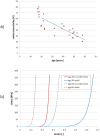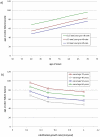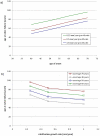A computational model of aging and calcification in the aortic heart valve
- PMID: 19536285
- PMCID: PMC2693668
- DOI: 10.1371/journal.pone.0005960
A computational model of aging and calcification in the aortic heart valve
Abstract
The aortic heart valve undergoes geometric and mechanical changes over time. The cusps of a normal, healthy valve thicken and become less extensible over time. In the disease calcific aortic stenosis (CAS), calcified nodules progressively stiffen the cusps. The local mechanical changes in the cusps, due to either normal aging or pathological processes, affect overall function of the valve. In this paper, we propose a computational model for the aging aortic valve that connects local changes to overall valve function. We extend a previous model for the healthy valve to describe aging. To model normal/uncomplicated aging, leaflet thickness and extensibility are varied versus age according to experimental data. To model calcification, initial sites are defined and a simple growth law is assumed. The nodules then grow over time, so that the area of calcification increases from one model to the next model representing greater age. Overall valve function is recorded for each individual model to yield a single simulation of valve function over time. This simulation is the first theoretical tool to describe the temporal behavior of aortic valve calcification. The ability to better understand and predict disease progression will aid in design and timing of patient treatments for CAS.
Conflict of interest statement
Figures








References
-
- Sahasakul Y, Edwards WD, Naessens JM, Tajik AJ. Age-related changes in aortic and mitral valve thickness: implications for two-dimensional echocardiography based on an autopsy study of 200 normal human hearts. American Journal of Cardiology. 1988;62:424–430. - PubMed
-
- Christie GW, Barrattboyes BG. Age-dependent changes in the radial stretch of human aortic-valve leaflets determined by biaxial testing. Annals of Thoracic Surgery. 1995;60:S156–S159. - PubMed
-
- Cowell SJ, Newby DE, Boon NA, Elder AT. Calcific aortic stenosis: same old story? Age and Ageing. 2004;33:538–544. - PubMed
-
- Schoen F, Edwards M. Valvular heart disease: General principles and stenosis. In: Silver M, Gotlieb AI, Schoen F, editors. Cardiovascular Pathology 3rd Ed. WB Saunders; 2001. pp. 402–442.

